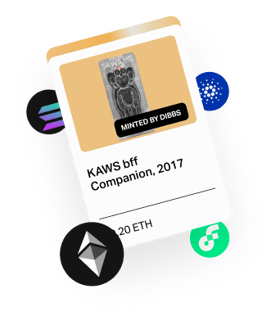How Can Asset-Backed NFTs Disrupt the Commodity Market?
Explore the transformative potential of asset-backed NFTs in various industries, their benefits, and the challenges in their implementation.

Non-fungible tokens (NFTs) like BAYC made headlines for becoming a cultural phenomenon. Their utility, however, extends far beyond digital art and collectibles. A particularly innovative application of blockchain-based tokenization is asset-backed NFTs. Asset-backed NFTs represent ownership rights associated with real-world assets like precious metals and agricultural produce on the blockchain.
This article explores the key advantages of asset-backed NFTs, how they’re revolutionizing various industries, and positive implications for the future.
Subscribe to get our best content in your inbox
By clicking “Submit” you agree to Dibbs
Privacy Policy and
consent to Dibbs using your contact data for newsletter purposes.

Why Asset-Backed NFTs are The Next Big Thing
Asset-backed NFTs harness the immutability, transparency, and security of their underlying blockchain. In doing so, they provide a multitude of benefits across diverse sectors.
Improves Transparency Across Supply Chains
Many businesses lack end-to-end visibility and transparency across supply chains as there are multiple stakeholders involved in the process. These stakeholders are often spread across different geographical locations which leads to communication delays and makes real-time data visibility challenging.
Further exacerbating this issue is the practice of data siloing. Each stakeholder typically maintains its own data systems and doesn’t readily share information with others. This leads to supply chain inefficiencies like overstocking or stockouts.
But by tokenizing commodities on the supply chain, all parties involved can track its end-to-end movement and access accurate data. This visibility improves the transparency and operational efficiency of the supply chain, and offers the following benefits:
- Prevents fraud: Commodities-backed NFTs and the underlying blockchains provide businesses a complete view of a product's journey from start to end. So, stakeholders can verify product status and supplier details at any point, and eliminate counterfeit product distribution to ensure consumer safety.
- Helps respond to crises quickly: Things like political issues, cyberattacks, and environmental changes can disrupt supply chains. But if goods are tokenized on the blockchain, all stakeholders involved can and take swift measures to resolve the problems caused due to the disruptions.
For example, during the COVID-19 pandemic, tokenizing toilet paper could have helped communicate sudden demand surges to manufacturers and prevented shortages by allowing them to ramp up production in time. - Improves brand engagement and loyalty: Today's consumers are mindful of their purchases. Whether it’s food or jewellery, they want reassurance that the raw materials are ethically sourced. Commodities-backed NFTs address these ethical sourcing concerns and offer businesses a competitive edge as their origin and journey can be traced accurately.
Removes Intermediaries
The value chains of many industries, particularly those involving precious metals like gold, are often complex and layered with intermediaries like brokers. Although these intermediaries connect buyers and sellers, they also engage in rent-seeking behavior and charge excess fees without contributing to value creation.
This inflates costs for businesses purchasing gold and distorts prices for end consumers. However, tokenizing gold and other metals and listing them on digital marketplaces enables businesses to bypass these intermediaries and their associated fees, leading to cost savings.
Increases a commodity’s liquidity
Most commodities like art are typically illiquid and are held for long periods of time before being sold as they’re accessible only to high net-worth investors.
But when they’re tokenized, they’re effectively divided into smaller, more affordable units, which can be bought, sold, or traded on digital marketplaces. This process significantly enhances the liquidity of the artwork and democratizes access. Consequently, even individuals without substantial wealth can partake in the ownership of these valuable pieces, fostering a more inclusive art market.
Challenges Brands Face With Asset-Backed NFTs
Despite the undeniable advantages of asset-backed NFTs, their implementation comes with its own set of challenges. Here are a few of them:
- Scalability: As businesses expand, the number of commodities-backed NFTs and stakeholders may increase correspondingly. In such scenarios, it's crucial that the underlying blockchain network maintains its ability to process a large volume of transactions swiftly and reach consensus promptly. To address these issues, brands should consider opting for scalable blockchains or implementing Layer 2 solutions to increase transaction speeds and reduce costs.
- Stakeholder opt-in: The effectiveness of asset-backed NFTs in a supply chain or any value chain depends on the participation of all stakeholders. Achieving this universal buy-in can be challenging due to added infrastructure costs and varied levels of blockchain understanding. However, demonstrating the potential for improved efficiency and implementing user-friendly interfaces can make the transition easier.
- Regulatory concerns: The regulatory landscape for blockchain and NFTs is still in its nascent stages. This creates a sense of uncertainty and risk for businesses looking and deters them from implementing asset-backed NFTs. But by obtaining legal counsel and staying abreast of legal trends, businesses can easily adapt to potential regulatory changes in the environment.
Create Asset-Backed NFTs Easily with Dibbs
The advent of asset-backed NFTs is a game-changer for various industries. From enhancing transparency and reducing intermediaries in supply chains to democratizing access to traditionally illiquid assets like art, the benefits are manifold.
However, like any emerging technology, it comes with its own set of challenges that need to be addressed for widespread adoption. One of the biggest problems is the development of infrastructure needed to tokenize assets.
Dibbs solves this problem for collectibles. It makes the tokenization process seamless and ensures their safekeeping by providing a physical vault to store the assets. This allows businesses to enter the NFT space easily. Schedule a demo with us to learn how we can help you create asset-backed NFTs easily.

Ben Plomion
Ben Plomion is Dibbs' Chief Marketing Officer. As a child, Ben collected comic books and Panini Football stickers. Now, Ben's PC consists of physical-backed NFTs.

